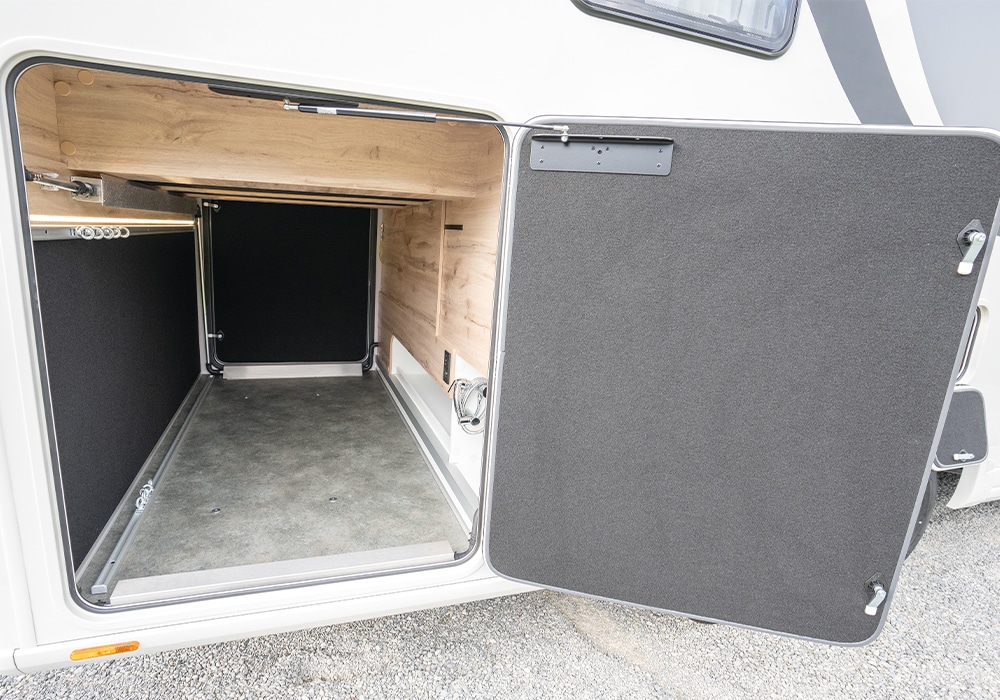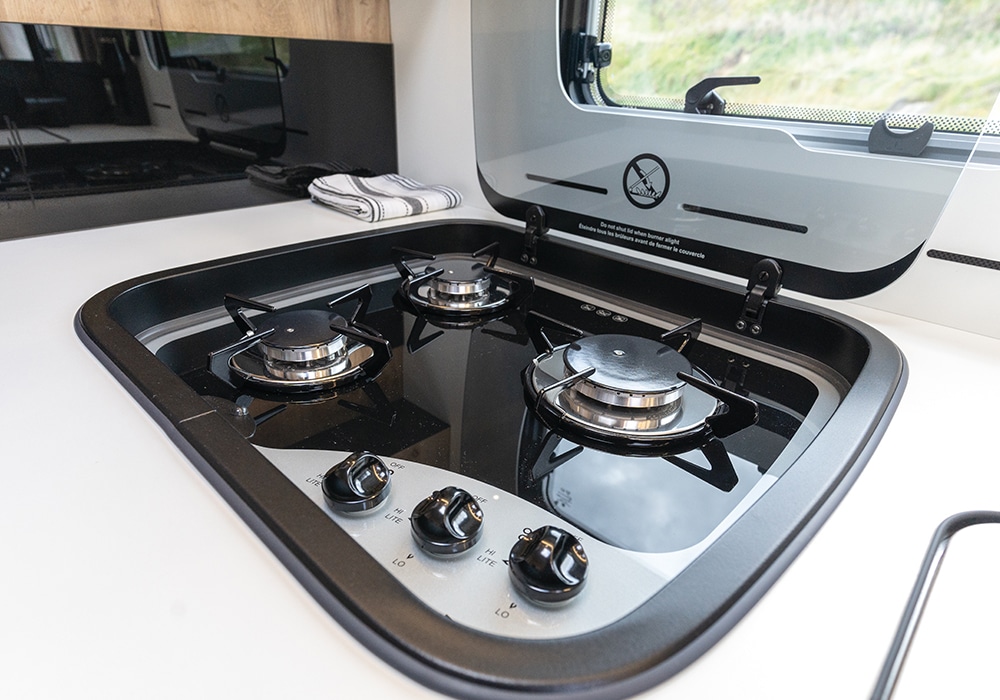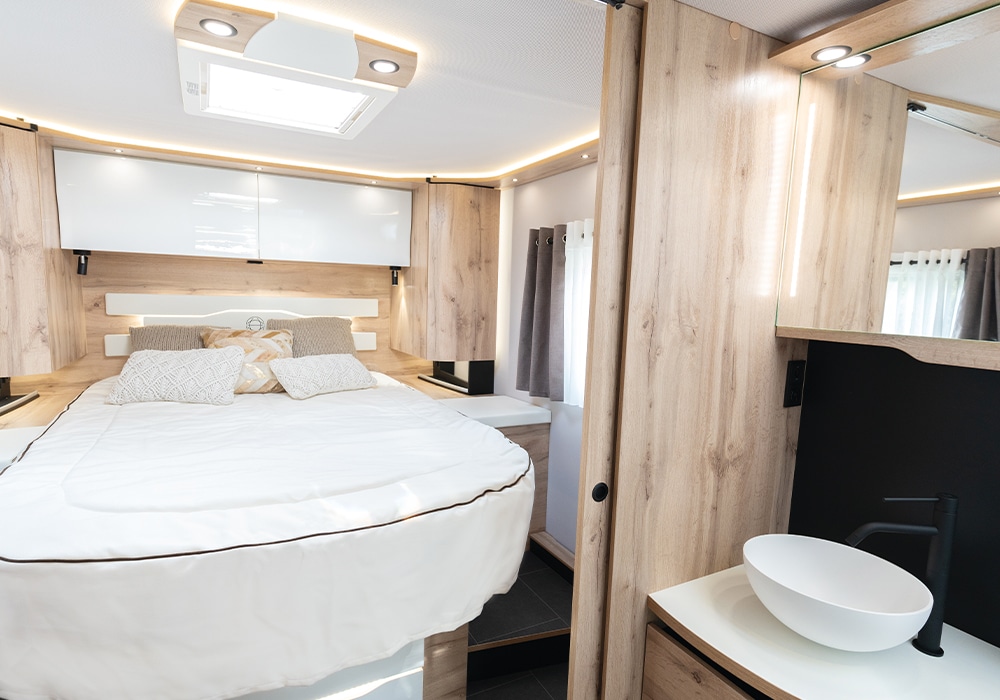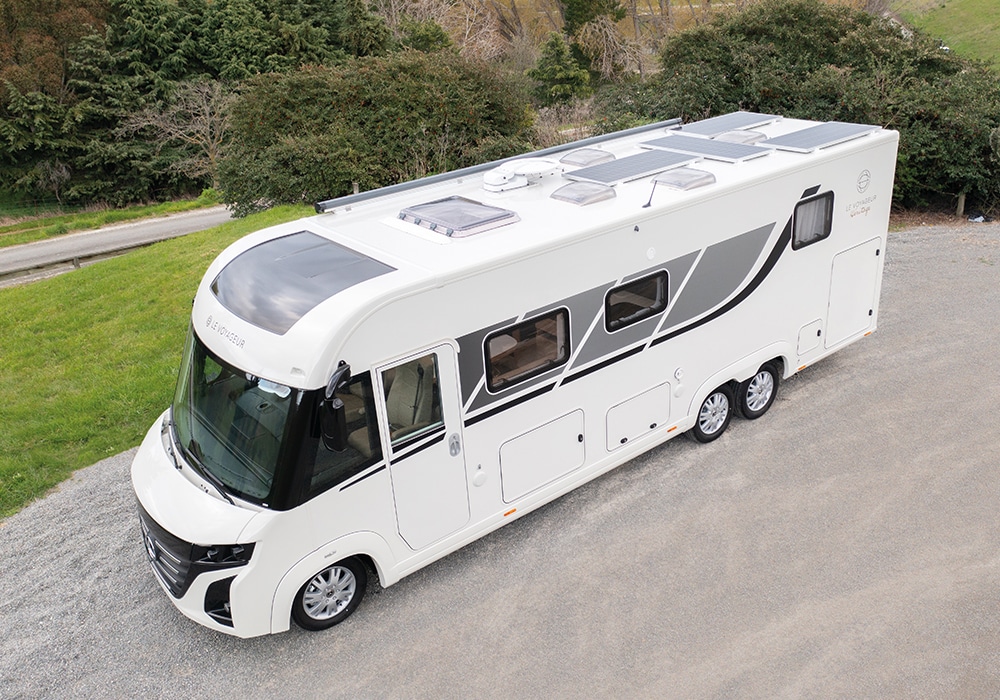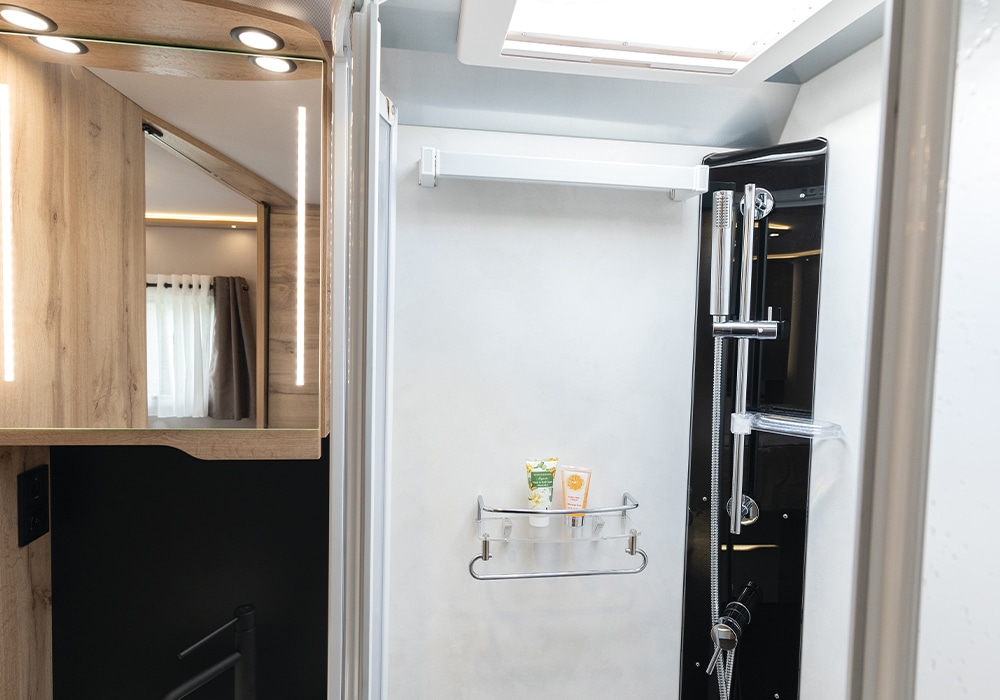Paul Owen took a trip to the high life when he got an insight into the Mercedes-based Le Voyageur Heritage LVXH 8.7CF.
When the Pilote Group acquired the far smaller bespoke motorhome manufacturer, Le Voyageur, in 1997, it began to make sweeping changes to the brand’s production base at Angers, France. The factory was rapidly expanded, and recent times have seen a highly automated RV furniture shop added, changes that were mostly focused on increasing production volume for the group as it began to expand into new segments of the mobile lifestyle market and create new brands.
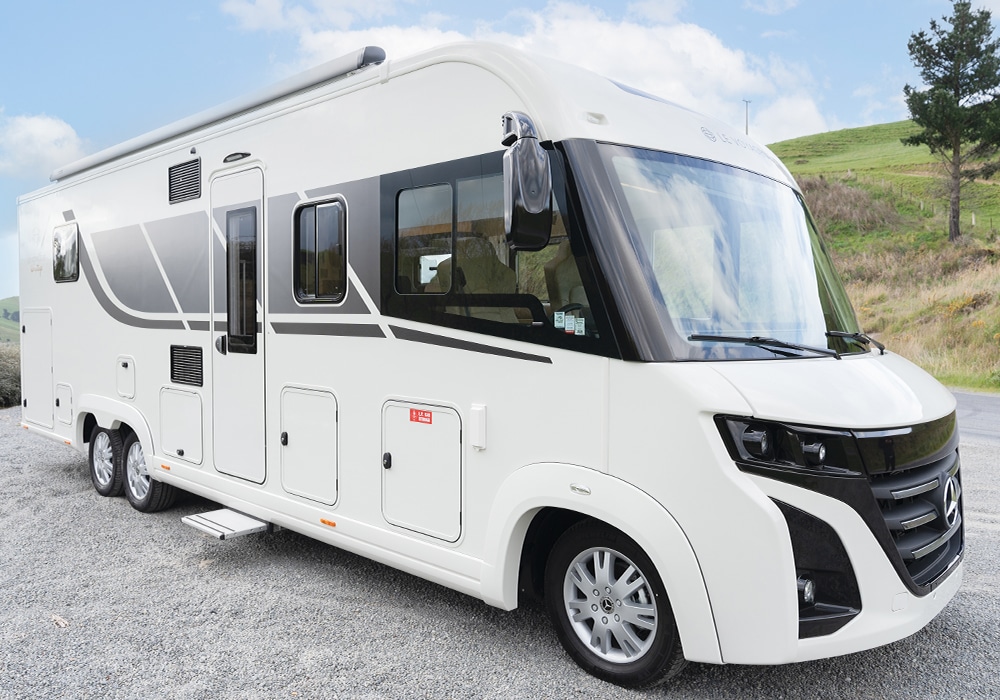
Throughout all this activity at the place of its birth 40 years ago, Le Voyageur remained niche and high-end, barely producing more than 300 luxurious hand-crafted motorhomes each year. The low production numbers continue to be a guarantee of exclusivity today, as befitting for the French alternative to a German-made Frankia (which is also built by the group at a factory in Nuremburg). That Pilote owns and operates two aspirational high-end motorhome brands shows how much the group has expanded since it moved away from caravans and made one of the first motorhome models to be manufactured in Europe back in 1970. The group is divided into two structures – one that overlooks the French operations and the two factories where Pilote, Bavaria, Mooveo, Joa Camp, Hanroad, and Le Voyageur motorhomes are made, while the German arm manages Yucon and Frankia at the Nuremburg factory. Marketing operations for all eight brands are increasingly being handled by the German team.
Which is where this $399,000 Le Voyageur Heritage LVXH 8.7 CF steps up and declares ‘I might still be made in France but I’m a lot more German than before.’ The new Heritage models are based on front-drive Mercedes Sprinter platforms, while the Le Voyageur Classic range continues to have Fiat Ducato foundations. Both ranges are of A-class motorhome bodies built atop Al-Ko air suspension and chassis, so it’s pretty hard to identify the Mercedes-powered Heritage from the Fiat driven Classic from the outside. However, it’s a different story when you step inside…
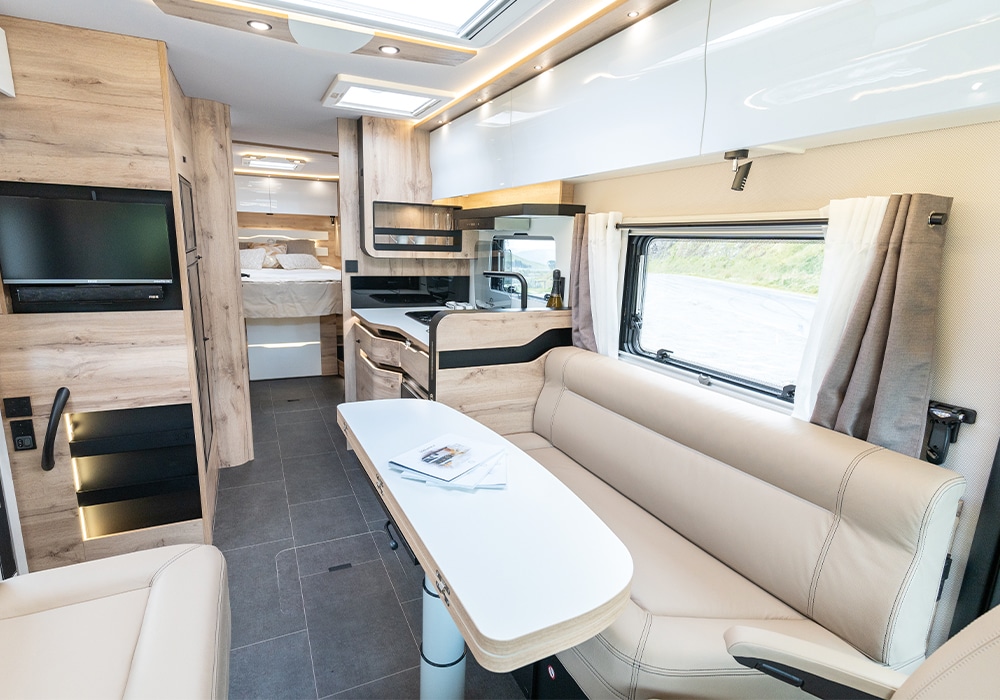
The Mercedes Factor
Both the Fiat and Mercedes powertrains used by Le Voyageur feature 2.0-litre turbo diesel engines pumping 180bhp (more or less) and driving the front wheels via nine-speed automatic gearboxes. This results in near equal driving performance and efficiency across the entire Le Voyageur range and identifying any difference between the two powertrains on the move requires keen sensitivity to noise, vibration, and harshness nuances, particularly as all Le Voyageurs come with sound suppressing double-floor bodies that are so well insulated that they’re virtual ‘cones of silence’.
It’s therefore up to the dashboards and electronic architecture of the donor vans to determine whether you’re better off spending a bit more on a Heritage instead of a Classic. The Ducato might be ‘the world’s most popular motorhome platform’ but the driving interface isn’t that flash and looks increasingly dated. There’s just nothing that the Fiat offers to match the huge 10.25” TFT central touchscreen of the Sprinter with its swipe access to multiple menus and a screen resolution that matches that of the best smartphones. When you step into the Heritage, settle into the driver’s seat, and fire it up by pressing the starter button instead of inserting a key, you feel a halo of Mercedes-ness glowing above your head as that huge touchscreen artfully lights up. By contrast, the Classic presents a Fiat driving interface with its orange LED screen nestled between analogue instruments offering a miniscule display that is much smaller than the Heritage’s. No prizes for guessing which interface appears the most appropriate for a $300+k motorhome.
Other driving pluses of the Heritage include crosswind stabilisation, automatic headlight monitoring, automatic parking brake, driver fatigue monitoring, and a 360° drone-view camera. A second TFT screen between the two circular bezels of the Merc’s digital instruments is an absolute mine of driver information. It’ll even tell you how much urea is left in the pollution-reducing AdBlue tank.
Weather? What Weather?
Like their Pilote-branded cousins, Le Voyageurs come with class 3 insulation, the top standard that requires a motorhome to maintain a heated cabin temperature at 20° C when it is -15 degrees outside. However, if there was a higher insulation standard to aim for, say for parking up in Antarctica, the Heritage would probably already meet it given that the insulation layers are thicker than a Pilote’s, and there’s a big gap between the two floors and that is heated as well to provide central heating for the top floor.
Also located in the generous gap between the floors are the 200L freshwater and 120L greywater tanks, which means there’s no frost protection needed to protect the plumbing in icy conditions. The ALDE hot water and habitation heating system takes care of everything with its efficient heat exchanger system.
The walls of the Le Voyageur feature a framing made of 35mm rot-proof treated hardwood, clad on the inside by dual layers of aluminium sheet and mesh, and on the outside by a 1.9mm-thick polyester moulding. This allows a 35mm-thick layer of insulation to fill in the gaps between the wooden framing. Polyester also seals and protects both sandwich floors, the lower one having a 25mm thick layer of insulation, while the top has a 20mm thick layer. The gap between the two is 26cm, allowing Le Voyageur to save space by mounting many of the cabin’s less attractive components there.
A five-year water tightness warranty backs up Le Voyageur’s construction of the A-class body, while the Mercedes mechanicals and electronics come with a two-year warranty.
Space and Grace
Le Voyageur likes to boast that the interior of the triple-axle 8.7 will give you “the sensation of moving around as if in real rooms” and it’s a brag that’s not all that far from the truth. At nearly 9m in length, and with an internal cabin length of 8.5m, this motorhome is as spacious as they come without resorting to a double-decker bus conversion.
A lot of that room is due to the way the Le Voyageur side walls overhang the wheel tracks of the Al-Ko chassis, and the ultralow ride height that the latter enables. The cabin floor sits quite low despite the fact that there’s a second floor below it, and this allows the ceiling to be located at a position that creates a wealth of head room. When you step up into the nicely designed shower cubicle of the Heritage, there’s still 1.9m of height from the raised floor of the cubicle to the ceiling. It’s a shower that tall folk won’t have to crook their necks to use. Where the Le Voyageur gets really special is with the way that its interior designers have made use the extra width of the A-class cabin. The furniture and appliances are of a similar size to those fitted to semi-integrated motorhomes with narrower cabins, allowing more floor space than the motorhome norm.
You could easily practice yoga or tai chi inside the largest Le Voyageur. Most other motorhomes would make you go outside first, no matter what the weather. In New Zealand, the LVXH 8.7 comes with premium leather upholstery as standard, and the hides cover seats that are nicely supportive. Apart from wider floor and increased visibility, the real strength of an A-class cabin is the way the front seats swivel into an ideal position to create a five-seat lounge. They’re at a perfect 45 degree angle to the two facing benches on either side of the versatile butterfly table, and there’s plenty of legroom for all occupants.
Another nice design feature is the way the overhead lockers narrow as they descend towards the floor, reducing the opportunity for heads to come into contact with them. Others include the stylised globe symbol etched into the gloss-white bedhead rails, framed by a strip of LED lights and the rustic look of the veneers chosen for the woodwork.
These are complemented by tasteful use of matt black and gloss white throughout the cabin, while the floor covering imitates the weathered grey hues of cedar planks. Naturally, you get the fully equipped kitchen, separate shower/separate washroom toilet, pullout pantry, 153L fridge, designer tapware, etc., you expect at this price point, but it all comes with that extra special garnish – space.
Voyaging Free
Daryl Smith of Blenheim-based exclusive Le Voyageur dealership, Deluxe RV Group, says the New Zealand version of the LVXH 8.7 ticks all the boxes for features that are only available as options in other markets, and these are included in the $399,000 price of the model. “We didn’t want to offer a base model and have people fit inferior equipment from the aftermarket to it,” he says. The Le Voyageur therefore comes with desirables like 400w solar panels (with optional lithium and solar upgrades available), a 200Ah habitation battery, a 1800w inverter feeding a network of 240v New Zealand plugs, a 5m electric awning with LED awning light strip, and a ceramic toilet. There are also four external cameras that combine to create a 360-degree overhead view of the motorhome and its surroundings, and this system can be left active when parked to enhance security. There’s also a hot/cold external shower and a huge bike-friendly garage with a door on either side. Seems this Le Voyageur is ready to do anything. With style.
| SPECIFICATIONS | |
|---|---|
| MAKE & MODEL: | Le Voyageur Heritage LVXH 8.7 CF |
| CHASSIS: | Mercedes Sprinter/Al-Ko hybrid cab/ chassis, front wheel drive |
| ENGINE: | 2.0-litre turbo-diesel, 177bhp |
| GEARBOX: | Nine-speed automatic |
| BERTHS: | 4 |
| LENGTH/WIDTH/HEIGHT: | 8750mm/2250mm/3090mm |
| FRESH/GREY WATER: | Fresh 200L/Waste 120L |
| GVM/PAYLOAD: | est. 5500kg/1400kg |
| UNLADEN MASS (TARE): | est. 4100kg |
| PRICE: | $399,000 |
For more information, visit https://www.deluxegroup.co.nz/


